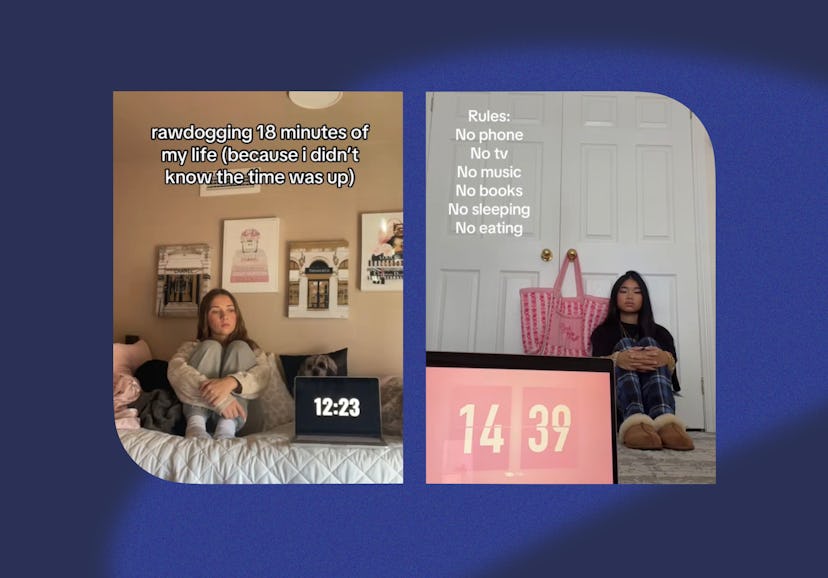Viral
It's Time To "Raw-Dog" Boredom
No screens, no music, just you and your thoughts.

Boredom is definitely a thing of the past. Instead of sitting around with nothing to do or watching the second hand trace around the clock, you can scroll on your phone, listen to music, watch TV — sometimes all at the same time — and instantly chase away the blah feeling.
It’s why you’re no longer bored on the weekends, in waiting rooms, or while trying to fall asleep. All you have to do is scroll social media, and life’s instantly exciting again. It’s also why the concept of “raw-dogging boredom” is going viral on TikTok. In an effort to take a break from it all, many people are setting a timer for 15 minutes and going into it with nothing — no phone, music, TV, sleep, or even a snack to keep them busy.
In a viral clip shared Oct. 8, @katend06 showed herself raw-dogging boredom while eerie, discordant piano tunes played in the background and a timer counted down in the foreground. In her comments, someone said, “Did you just put yourself in timeout?” Another wrote, “This will be the most beneficial trend for all of humanity.”
Creator @.katymorris also gave it a try, saying it was “honestly so peaceful” and adding that she would do it again, while @olivia.unplugged vowed to raw-dog boredom for at least 15 minutes every day since “constant stimulation is not meant to be our baseline.” While some enjoyed it or saw the benefits, others were bored (and stressed) pretty much immediately. And sure, TikTok users may just be rebranding a meditation or moment of mindfulness, but if it’s working, who am I to judge?
Here, therapists weigh in on why it’s actually good to be bored, as well as how to get better at doing nothing.
It’s Good To Be Bored
According to Eliza Davis, LCSW, a psychotherapist and founder of Eliza Davis Therapy, most people hate being bored. “Boredom is often associated with feelings of not doing enough or not doing something meaningful, which can make you feel unproductive,” she tells Bustle. Silence can feel like you’re slacking.
Constant texts, TV, and TikToks also flood your brain with dopamine, aka the feel-good hormone, and according to Davis, it trains you to constantly anticipate something new. Without an onslaught of information, sound, and things to look at, you can feel restless — and even uncomfortable.
Embrace The Feeling
If you’re used to being entertained 24/7, boredom can even be kind of scary. It feels weird to sit with your thoughts and come back into your body, but according to May Han, LMFT, a therapist at Spark Relational Counseling, this process is actually good for you.
Sitting with no distractions or entertainment shifts your nervous system from a stressed-out fight-or-flight mode and engages the parasympathetic system, which is calming and soothing to the body and brain. It takes about 15 minutes to adjust, she says, but if you give it time, you’ll actually start to relax — and maybe even enjoy it.
Doing this for a few minutes a day can help you regain your attention span, making it easier to slow down and focus on one thing at a time. It also gives you a chance to think and reflect, which is essential to processing memories and emotions. It might even help you feel more creative since you’ll want to fill the void and try something new. “Honestly, everyone can benefit from 15 minutes of silence,” says Davis.
How To “Raw-Dog” Boredom
On TikTok, many people raw-dog boredom by sitting on their bed while a timer ticks down, but according to Davis, you don’t have to take this trend so seriously. “Try showering without any background noise, walking to the subway without music playing, or eating dinner without the TV on and focusing on your meal,” she says. It’ll give you the same benefits without feeling like you’re stuck in timeout.
If you really hate the idea of being alone with your thoughts, Davis says to start with just one minute of quiet. Turn off the TV, close your laptop, put down your phone, and see how it feels to sit and think for 60 seconds. “Setting small, manageable goals for yourself will make tolerating the discomfort of silence more doable over time,” she says.
If you want to treat your silence as more of a meditation, Han recommends practicing mindful breathing during your 15-minute break. “You can breathe in through your nose normally and try breathing out through your mouth as if you were blowing through a straw,” she says. “You may also shift your attention to sensing your body — where does your body feel tight or uncomfortable, where does it feel soft or tense? These are great ways to practice being with yourself again.”
Sources:
Eliza Davis, LCSW, psychotherapist, founder of Eliza Davis Therapy
May Han, LMFT, therapist at Spark Relational Counseling